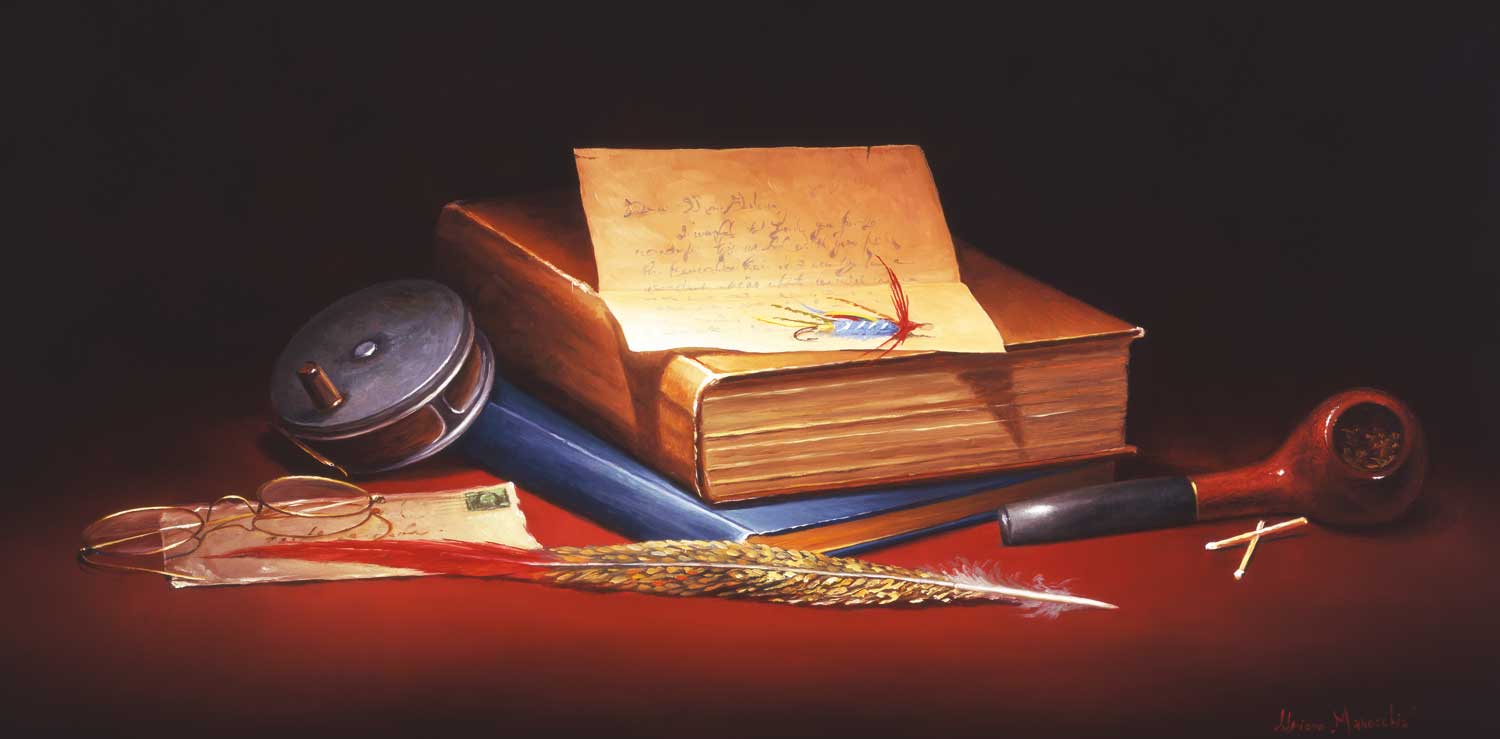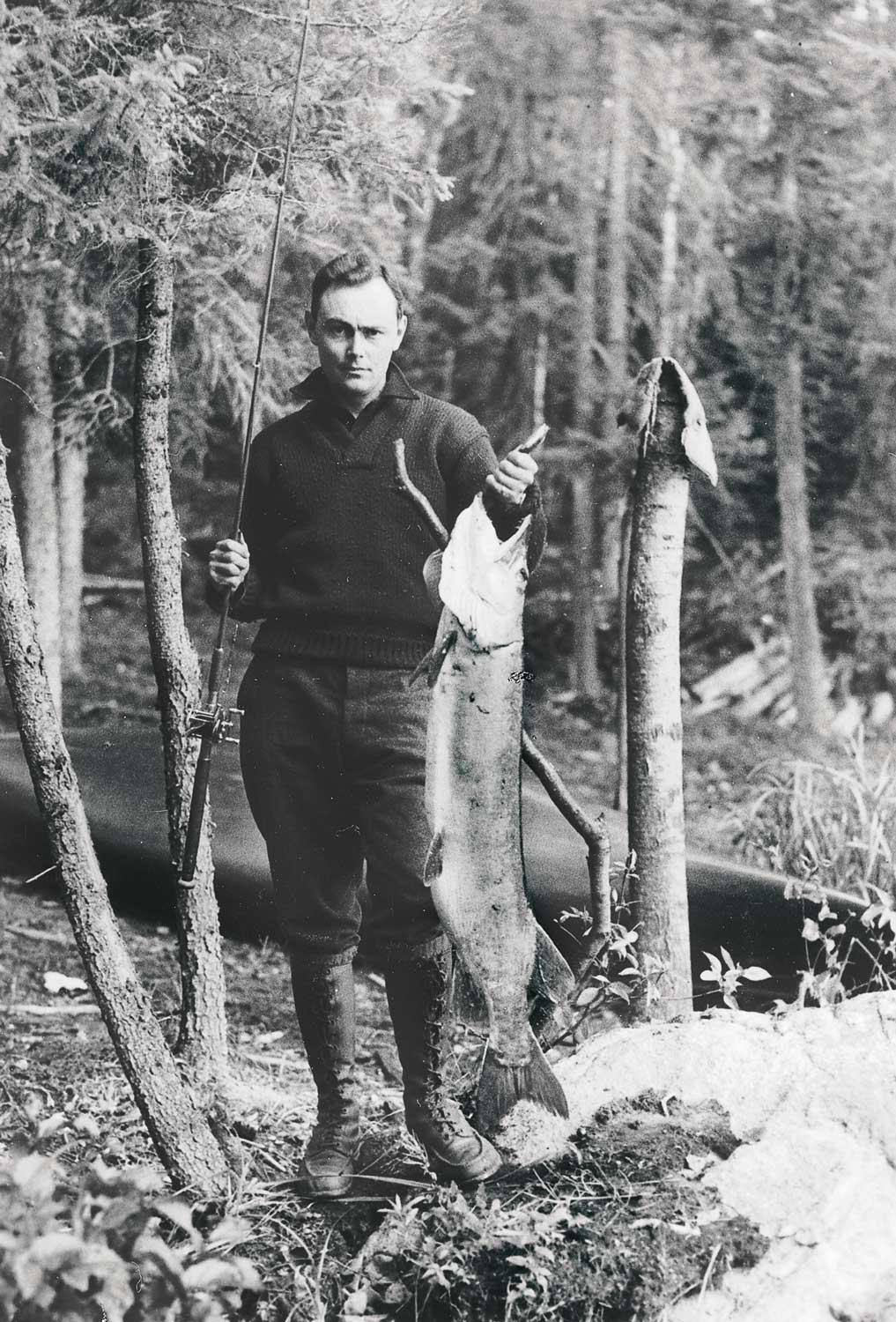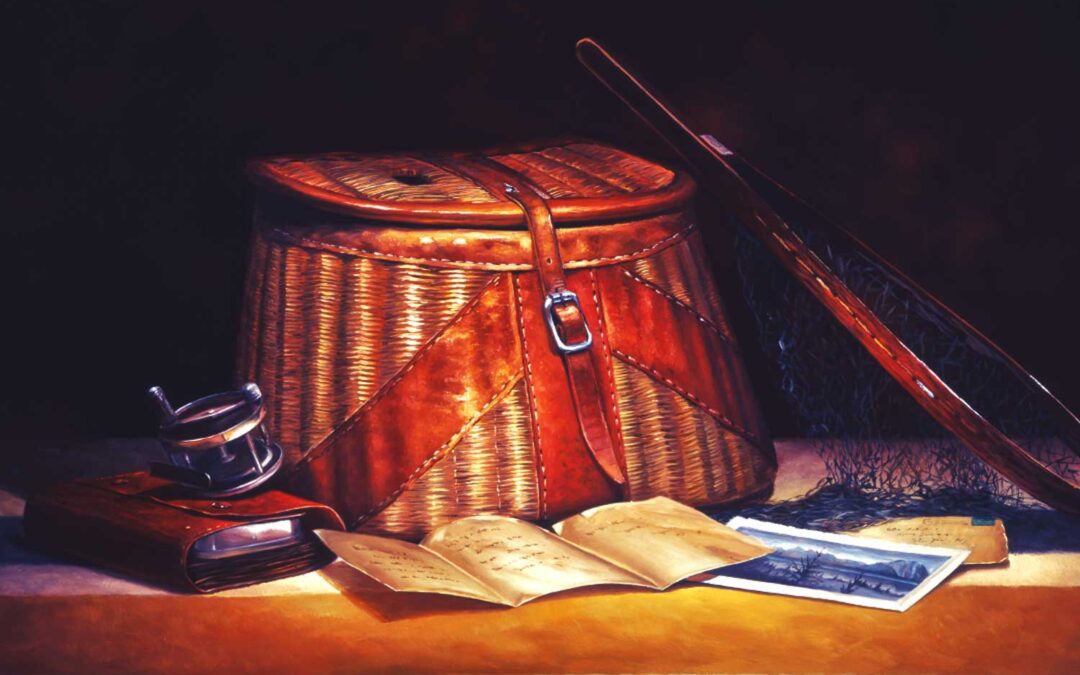Is all in readiness for the Jehovian clang of his alarm clock at 4 a.m.? Has he made good use of the idle winter months? Does he have his tackle in shape, his gear laid out, his reel oiled, his line all greased? By way of answer, let us glance into the home of a typical angler as the great event draws near . . .
’Tis the night before opening day – let Clement Moore sue me – and all through the house not a creature is stirring except for his spouse, who has gotten up half an hour ahead to start the coffee and make some peanut butter sandwiches. His waders are hung by the chimney with care, in hopes that the patches he finally got around to gluing on last midnight will be dry by morning. His freshly varnished rod – he’s been meaning to get the job done ever since last September – dangles from the chandelier, still too sticky to handle. His leaders are soaking overnight in the bathtub so they will be thoroughly soft by the time he gets to the stream tomorrow and remembers where he left them. His boots are up in the attic, if he could only find them; his one pair of wading socks have holes in both heels, and somebody, I said somebody, has deliberately mislaid his creel. His line is wound in a cat’s cradle around the bedposts; his flies lie in a jumbled heap on the bedside stand; and he has collapsed on the pillow to grab a few minutes’ shut-eye before his partner arrives.
Out on the lawn there arises a clatter as a jeep halts in front and his partner sounds the horn vigorously, waking everyone in the neighborhood and eventually the fisherman himself. He springs from his bed, struggling to untangle himself from the trout line in which he has become thoroughly enmeshed.

An Invitation for Next Summer by Adriano Mannochia
Sleepily he thrusts his right foot into the left leg of his trousers, shoves an arm through the neckband of his shirt, crams everything else in sight into his landing net, and rushes downstairs, shouting to his wife to please kindly try to recall just what in blazes she did with his pipe. After a frantic search the pipe is discovered between his teeth, where he left it last night when he went to sleep, and he hauls on his waders and starts out the front door, returning almost immediately to unhook his suspenders from the newel post.
The jeep is halfway to Sullivan County before he remembers that he put his trout reel on the hall table so that he would be sure to see it, his fishing jacket is still hanging on the coat rack, and he forgot to bring the peanut butter sandwiches.
“Next year,” he says bitterly, because in addition he has just remembered that his license is in the pocket of the fishing jacket, “next year I won’t leave everything till the last minute. Next year I’ll get ready in time.”

Although his first love was trout, Corey Ford pursued other gamefish as well. He caught this muskie on a 1929 trip into the Canadian wilderness.
For the benefit of the repentant angler, therefore, I have listed a few things he can do to get ready for the coming trout season. If he will follow these hints carefully, and make a point of going upstairs each night as soon as dinner is over and spending the next five or six hours locked up all alone in his den, he will find that his gear is in perfect shape when opening day arrives. He will also find that his wife has left him and gone home to Mother.
Care of Tackle. Every year a number of articles are written on the care and preservation of fishing tackle. The angler should read all these articles carefully, nodding his head from time to time and murmuring sagely: “That’s a pretty good idea,” or “This fellow sure knows what he’s talking about.” After reading each article, he should clip it out of Field & Stream and file it away in a large folder entitled: “Opening Day – things to do in preparation for.” This file will come in handy later to wrap fish in.
One of the most important things to do in preparation for opening day, of course, is to sort over your collection of trout flies and rearrange them so you can put your hands on any pattern you want without delay. To accomplish this task, turn all your fly boxes upside down and dump the contents in a heap on the tackle-room table. Pour yourself a small spot of Scotch, because this job will probably take quite a while, and paw over the assortment of flies before you.
Select a No. 14 fan-wing Cahill, hold it aloft and turn it slowly from side to side, trying to recollect where you worked it last. Let’s see, now, wasn’t that the fly you used to take that three-pound squaretail on the Albany, right out from under Dan Holland’s nose? Place it back reverently on the pile, pour yourself another jigger of Scotch, and pick up a No. 12 Quill Gordon. This would be the one you borrowed from Mac to hook that 24-inch grayling on Tanalian Creek in Alaska. Return it to the heap on the table, fill the jigger glass again, and pick out a small Black Gnat. Paul Clowes gave you that one, the time you took the four-pound rainbow on the North Fork of the Snake. This black-and-white fly is the one Sid Hayward tied for you from the hair of your own bird dog. This Blue Dun is the one you used last year with Austin Scott on the Connecticut.
Continue brooding thus over the collection, occasionally refilling your glass as you look over your favorite patterns one by one, until your wife shouts upstairs that it’s three o’clock, for heaven’s sakes, and aren’t you ever coming to bed? Dump the flies back in the boxes, and plan to sort them out tomorrow night instead. After all, you’ve got all winter.
Equally important in getting ready for opening day is to go through the pockets of your fishing jacket and remove all the superfluous items that have collected in them during the past season. There is nothing more cumbersome than a loaded fishing jacket, its sides bulging so you can barely move your arms to cast. The best way is to empty all the contents from the pockets, sort them over carefully one by one, and put back only those essential items which you could not possibly do without, such as:
1. A piece of string about ten inches long. (You never can tell when you’ll need a piece of string.)
2. A hunk of copper wire. (You never know when you’ll want a hunk of copper wire.)
3. A button. (You’d better keep that, because it probably came off something.)
4. A pack of stale tobacco, half full. (Might come in handy if you ever run out of tobacco.)
5. An empty tin box that you could use sometime to keep spare flies in; a red bandanna handkerchief, smelling slightly of fish, in case you want to wrap something up; a bottle of fly dope with some sticky brown stuff in the bottom, in case you need to renew the prescription; a swivel, in case you ever want a swivel; a reel with the handle missing, in case you find the handle again; part of a chocolate bar, which has melted and stuck to the inside of your pocket so that you can’t get it out; a broken scale, which could easily be fixed; a key to something, if you could only remember what it fits, and several nice-looking streamer flies with the barbs broken off, because it seems a shame to throw them away.
6. A safety-pin, which you reluctantly decide to get rid of, because after all you’ve got to get rid of something. (Later on, when your galluses break in the middle of the stream, you will discover that the one thing in the world you need is a safety-pin.)
Repairing Waders. Only one thing is worse than discovering at the last moment that there is a hole in one leg of your waders, and that is discovering there are holes in both legs. Veteran fishermen wince at the very thought of striding across a pool and feeling their waders fill with ice-cold water. In order to avoid this, many fishermen fill their waders with warm water before stepping into the stream.
There are several ways of finding out whether your waders leak. One method is to fill the bathtub with water, put on your waders, and sit down in the tub. This method is not entirely satisfactory, since the immersion of the fisherman results in a corresponding displacement of water that elevates the level in the tub to a point slightly higher than the waist of the waders, causing him to assume a rather silly expression when his wife glances into the bathroom and asks him acidly just what he thinks he’s doing, and wouldn’t he like her to bring him one of Junior’s celluloid ducks?
A better method is to take the waders down into the cellar, pull them inside out, and hang them from a couple of nails in the ceiling. Fill a bucket with water, pour it into the waders, and watch closely to see whether a leak appears. Draw another bucket of water, pour it down inside, and inspect the legs carefully. Continue to fill the waders with water until the nails in the ceiling give way, dropping the waders and flooding the cellar floor to a depth of several inches. Quietly wade back upstairs.
Probably the best method is to wait till you get to the stream. If there’s a hole in your waders that lets the water in, cut another hole just below it to let the water out again. You’ll end up just as dry as anybody else.
Preparing the Fishing Hat. The most indispensable item in any fisherman’s equipment is his hat. This ancient relic, with its battered crown and well-frayed band, preserves not only the memory of every trout he ever caught, but also the smell. In case his wife ever carries out her threat to give it away to the garbage collector, the fisherman may proceed as follows:
After a hasty visit to the lawyer’s to institute divorce proceedings against his wife (this step is automatic), he should repair to the nearest hat store and purchase the first headgear he sees. If it does not fit, yank it down over the skull until the stitches give way, so that it feels better. Rip out the silk lining and hand it back to the clerk, roll the rest of the hat into a tight ball, and sit on it all the way home in order to start breaking it in. Later, as time permits, the following additional care is recommended:
1. Impregnate it thoroughly with fish slime, asafetida, old axle grease, diesel oil, citronella and hair tonic.
2. Festoon the band with barbed flies until it resembles a moulting hen.
3. Fill the crown with water and let it stand in the sun a few days until the seams start coming apart.
4. Place it in the driveway, crank up the garden tractor, and drive it back and forth over the hat, shoveling on an occasional forkful from the compost heap. Knead thoroughly.
5. Last but not least, place it on a stump and shoot it with a 10-gauge magnum at approximately 50 feet. If the fishermen uses double 00 buck, and his aim is right, the result should be a hat which he needn’t be ashamed to wear on any stream.
Here, then, are a few things the prudent angler can do to get himself set for the arrival of opening day. Does he take advantage of the suggestions I have carefully listed above? Does he profit from his past mistakes, and spend his nights over the winter to good purpose? Will he have his tackle all ready in plenty of time next year, instead of leaving everything as usual till the last minute?
For the answer to these fascinating questions, turn back and start over again at the beginning of this article.
Note: Tomorrow’s The Day originally appeared in the January, 1952 issue of Field & Stream. It is reprinted here with permission of Dartmouth College and with the assistance of Laurie Morrow.

